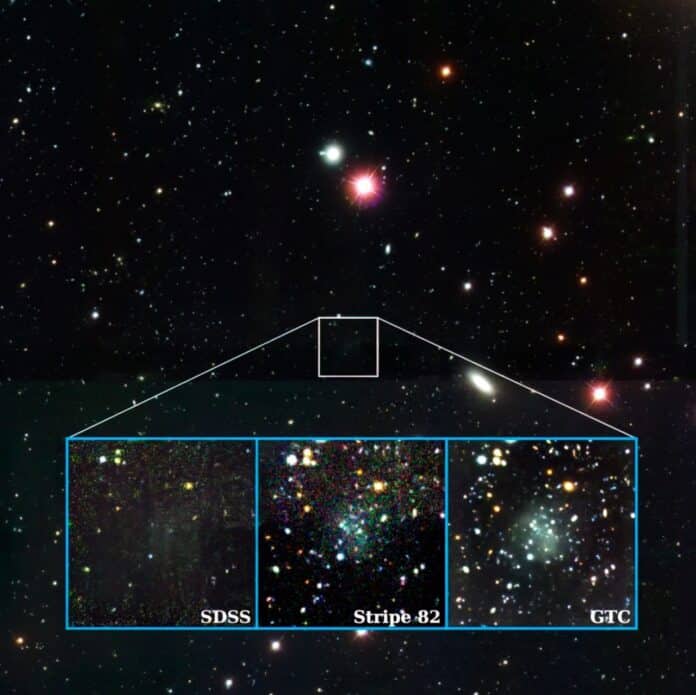Almost all dark galaxies have eluded detection by traditional surveys such as the Sloan Digital Sky Survey (SDSS). The low surface brightness of these galaxies, and hence their low surface stellar mass density, suggest that the energy density released by baryonic feedback mechanisms is inefficient in modifying the distribution of the dark matter halos they inhabit.
For this reason, almost dark galaxies are particularly promising for probing the microphysical nature of dark matter.
Astronomers led by Mireia Montes at the Instituto de Astrofísica de Canarias (IAC) have identified the largest and most diffuse galaxy known. Named “Nube” (Spanish for “Cloud”) by the 5-year-old daughter of one of the researchers, this nearly invisible dwarf galaxy was discovered using data from the Gran Telescopio Canarias (GTC) and the Green Bank Radiotelescope (GBT). Nube’s stars are so widely distributed in a vast volume that their surface brightness is extremely faint, making them almost undetectable in previous sky surveys.
The name “Nube,” meaning “Cloud” in Spanish, was suggested by the 5-year-old daughter of one of the researchers due to the object’s diffuse appearance. Its extremely faint surface brightness caused it to go unnoticed in previous surveys of the sky, earning it a ghost-like quality. This is attributed to the galaxy’s stars being widely dispersed in a large volume.
Nube stands out with distinct properties compared to previously known objects. The research team estimates it to be a dwarf galaxy, ten times fainter than others, yet ten times more extended than objects with a comparable number of stars. To provide a sense of scale, Nube is one-third the size of the Milky Way but possesses a mass similar to that of the Small Magellanic Cloud.
Mireia Montes, the first author of the article and a researcher at the IAC and the ULL, said, “With our present knowledge, we do not understand how a galaxy with such extreme characteristics can exist.”
Ignacio Trujillo, the study’s second author, has been scrutinizing a specific section of the sky based on Sloan Digital Sky Survey (SDSS) images for several years. This falls under the Legado del IAC Stripe 82 project. During a data revision, they identified a faint patch that sparked interest and led to the initiation of a research project.
To confirm the nature of this patch in the survey, the team used ultra-deep multicolor images from the Gran Telescopio Canarias (GTC). The next step involved estimating the distance of Nube, which proved challenging due to its faintness. An observation with the Green Bank Telescope (GBT) in the U.S. suggested a 300 million light-year distance.
However, upcoming observations with the Very Large Array (VLA) radiotelescope and the optical William Herschel Telescope (WHT) at the Roque de los Muchachos Observatory in La Palma will provide further insights to validate or refine this distance estimate.
Ignacio Trujillo said, “If the galaxy turns out to be nearer, it will still be a bizarre object, and offer major challenges to astrophysics.”
Montes said, “Nube has the astronomers puzzled. Prima facie, the team explains, there is no interaction or other indication of its strange properties. Cosmological simulations are unable to reproduce its “extreme” characteristics, even based on different scenarios. We are left without a viable explanation within the currently accepted cosmological model, that of cold dark matter.”
“The cold dark matter model can reproduce the large-scale structures in the universe, but there are small-scale scenarios, such as the case of Nube, for which it cannot give a good answer. We have shown how the different theoretical models cannot produce it, which makes it one of the most extreme cases known until now. With this galaxy and similar ones which we might find, we can find additional clues that will open a new window on understanding the universe.”
Ignacio Trujillo said, “One possibility which is attractive, is that the unusual properties of Nube are showing us that the particles which make up dark matter have a tiny mass. If this was so, the unusual properties of this galaxy would be a demonstration of the properties of quantum physics, but on a galactic scale. If this hypothesis is confirmed, it would be one of the most beautiful demonstration of nature, unifying the world of the smallest with that of the largest” he concludes.”
Journal Reference:
- M. Montes, I. Trujillo, et al. “An almost dark galaxy with the mass of the Small Magellanic Cloud.” A&A. DOI: 10.1051/0004-6361/202347667
